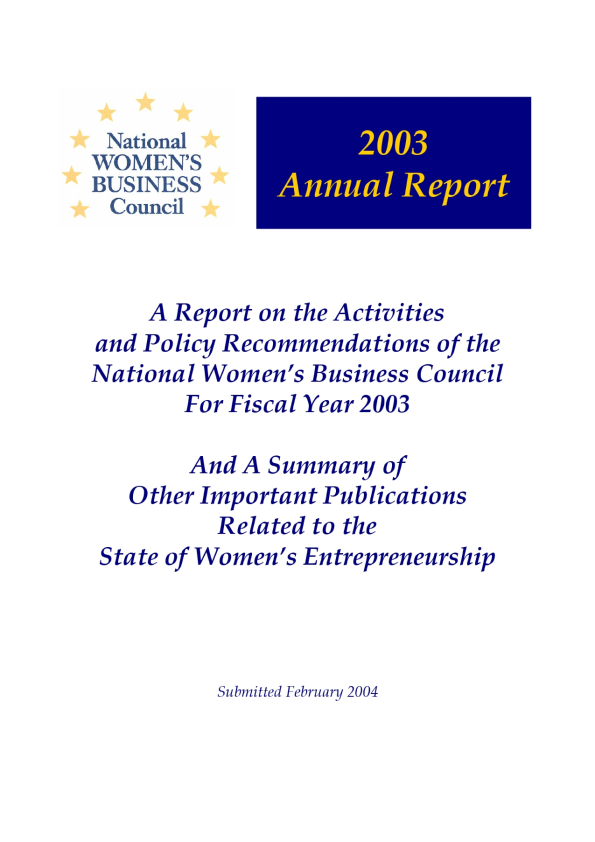
To the President, Members of Congress SBA Administrator and the Women’s Business Community:
I am pleased to submit, on behalf of its members, the National Women’s Business Council’s Annual Report for Fiscal Year 2003.
The Council is honored to be the Federal Government’s only independent advocate for this Nation’s 10.1 million businesses with 50% or greater women’s ownership.
The unprecedented growth of women-owned businesses during the past decade continues its historic run. Privately-held businesses in which women are majority owners – 6.2 million firms – are growing in number at twice the national average, and adding jobs at 1-1/2 times the national average.
Overall, businesses in which women own at least 50% of the company generate $2.3 trillion in annual revenues and provide jobs for 18.2 million people. Still, there remain numerous obstacles to sustained vitality. Foremost among them are: the escalating cost of small business health insurance, barriers to accessing capital and difficulty entering government markets.
As I look back over this past year, I am gratified that the National Women’s Business Council continues to identify, research and advocate for those issues which are most influential to the success of women business owners. Not only have we found new and innovative ways to bring critical facts and research to policy discussions but, most importantly, we have achieved our objective to engage more and more women business owners in those discussions.
During the past year, the National Women’s Business Council has published a number of research studies, Issue in Brief papers, and other publications on topics of significance to the women’s business community, which are summarized in this report. We have expanded our communications outreach activities and launched initiatives to help further connect the women’s business community to current public policy debate. Of special note are the following:
- The publication of a background research report and proceedings from a roundtable discussion held on Capitol Hill focusing on access to affordable health care for small business owners;
- The publication of an analysis of the availability and common characteristics of successful mentoring programs available for women business owners;
- A summary of the findings related to women’s entrepreneurship contained in the Global Entrepreneurship Monitor research reports from 1999 to 2002;
- A summary and analysis of Federal procurement from women-owned small businesses from FY1997 to FY2002;
- Fact sheets pulling together information on several populations of women-owned businesses (including African-American, Asian American, Latina and Native American) from multiple sources;
- The establishment of a monthly toll-free issues conference call, “Women’s Business Connection,” which provides a platform for dialogue between policy experts and women business owners; and
- A summary of the state economic networks that exist to promote women’s enterprise development and provide policy guidance, including a resource guide with contact information.
And we have only just begun. Research is a vitally important tool for both program development and public policy action and in the coming months, the Council will publish several important studies, including:
- Analysis of the growth, the number, and economic impact of women-owned employer establishments from 1997 to 2000, based on tabulations received from an exclusive agreement with the Census Bureau;
- A summary and analysis of loans and loan guarantees made by the U.S. Small Business Administration to women-owned businesses over the past five years;
- A distillation and summary of the best practices in the public and private sectors of the United States for women’s enterprise development, updating a similar report published in 1999 by the Council in advance of an international women’s business conference; and
- An analysis of the correlates of success of the SBA’s women’s business center program, based on an analysis of the information submitted to the SBA by these centers, plus macroeconomic and other data.
New in this year’s Annual Report, is a compendium of notable research projects published over the past12monthson topicsrelatedtothestateofwomen’sentrepreneurship.Asthestudies confirm, that women-owned businesses are a vital force for growth – making significant contributions to the well-being of our economy.
I look forward to continuing our good work in the year ahead. On behalf of all the members of the National Women’s Business Council, I commit the Council to carry out its mission to promote bold initiatives, policies, and programs for women’s business enterprises.
Respectfully,
Marilyn Carlson Nelson
Chair, National Women’s Business Council

